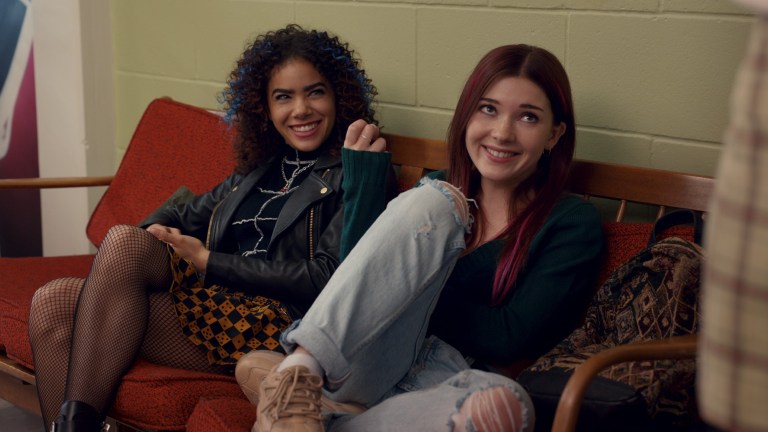How Ginny & Georgia Season 2 Fixes Two Major Season 1 Issues
Ginny & Georgia season 2 avoids unfortunate memeable moments with a more sophisticated treatment of its characters.

This article contains spoilers for Ginny & Georgia season 2.
Netflix’s mother-daughter drama Ginny & Georgia was a pandemic era hit when its first season debuted back in February 2021. The show is about single mother Georgia Miller (Brienne Howey) who moves her teenage daughter Ginny (Antonia Gentry) and son Austin (Diesel La Torraca) to Wellsbury after the death of her rich husband. While the show’s comparisons to Gilmore Girls certainly helped, it was really the dramedy’s Taylor Swift joke and “oppression Olympics” scenes that led to the show going viral … while also leaving it with a lot to improve upon for season two.
Ginny & Georgia season 2 picks up with Ginny and Austin living with Ginny’s father Zion (Nathan Mitchell) after discovering their mother murdered their stepdad. This season has sparked a lot of conversations around how the show has improved some of the major issues of season one – particularly its discussion of race and mental health. Here is how Ginny & Georgia season 2 improved upon two of season 1’s blindspots.
Ginny & Georgia’s Depiction of Mental Health
Ginny & Georgia aims to push boundaries with its stories and while it doesn’t always strike viewers in the ways it wants, there is always at least an underlying authenticity attempted. This is particularly shown with the show’s discussion of mental health. Early on in season one we learn that one of the titular characters, Ginny, self harms with a lighter as a way to deal with her feelings towards her mother’s friend-like parenting style and lack of boundaries. But the first season is guarded in its depiction of the act. Ginny’s struggles are very much a secret from everyone except our resident window climber and Ginny’s love-interest Marcus (Felix Mallard) as the show decided to focus more on the flashbacks of Georgia’s past and other various teen dramas.
Despite that, the first season does also allow us to learn about Marcus’ own struggles with depression after the loss of his friend. While this is also relatively glossed over in the first batch of episodes, the show rectifies this with season two as it shows Marcus turning to drugs and alcohol to cope with his descent into depression. The differences in Marcus are shown across the whole season but particularly in episode eight which is a Marcus-centered story as he walks us through his feelings via voiceover. From the fake smiles to the slow speaking, we see Marcus get to the point where he can no longer mask his suffering nor shoulder anyone else’s pain and so he breaks up with Ginny despite loving her. The episode is a beautiful yet haunting exploration into how mental health is a constantly ongoing concern. There is no quick fix nor a permanent solution.
There are so many scenes in season two that showcase the series’ improvement when discussing mental health but the moment in which Georgia finds out that Ginny has been self-harming and asks Ginny to show her where is an incredibly emotional watch. While we never see Ginny’s scars on screen, Georgia’s reaction and actions afterwards are heartwarming and has led to many people online applauding the rawness of the moment.
Additionally, Ginny and Georgia’s decision to bypass the damaging stereotypical portrayal of Black people not needing therapy and having Ginny’s Black father be the one to recommend counseling with a mixed-race therapist so Ginny can be understood is a powerful decision made within the show. Especially as it’s in contrast to Georgia who ignores mental health as an idea until she’s forced to confront it by Ginny’s self-harming and necessary therapy sessions where Georgia discovers her part in Ginny’s trauma.
Self-harming and depression are not the only two issues around mental health discussed. The show also explores body dysmorphia with Ginny’s friend Abby (Katie Douglas), who tapes her legs and seems to also be suffering from an eating disorder. Abby’s suffering is pretty invisible to everyone as a reflection on how mental health issues often can’t be seen.
Ginny & Georgia overcomes TV’s default reaction to make a punchline out of sensitive subjects. While Ginny does joke with her father about her therapist making her keep a journal (“Dear Diary, today I wanna burn. When, oh when will I ever learn?”) the joke is used more as a form of liberation and open discussion to what can make her therapy more beneficial to her. It doesn’t use mental health for a quick laugh or decide to ship off characters for a few episodes and have them come back shiny and new. The show contributes to finally giving mental health treatment the attention it deserves on TV.
Ginny & Georgia’s Exploration of Race
On TV, being mixed-race rarely gets explored beyond the fact mixed-race characters often express they feel as though they don’t fit in, on either side of their identity. This is something examined in season one through Ginny being asked “what” she is because she’s so “exotic looking.” The offhand racist comments Ginny experiences alongside the treatment she receives from her racist white English teacher Mr Gitten (Jonathan Potts) leads to the infamous oppression Olympics scene in which Ginny and her then half-Taiwanese boyfriend Hunter (Mason Temple) decided to go back and forth over who has the worse racial experience. Ginny tells him he’s barely even Asian and he retorts, “but I’ve never seen you pound back jerk chicken…So really how Black are you then?” The scene is a mess and was extremely controversial, but it highlighted how being biracial is a completely different experience than being monoracial. Racial identity is complex and needs to be explored sensitively, a point season two does well to acknowledge.
Ginny & Georgia season 2 furthers discussions around being biracial and explores it around the context of being raised predominantly by a white parent, who the child feels fails to understand the Black experience and struggles they may face. This particularly comes to blows for Ginny when Georgia hears Ginny’s poem at the open mic night and she asks Ginny what it is she doesn’t understand. Ginny’s hits back: “That I’m Black, for one.” It leads to Ginny discussing how Georgia dressed as Scarlett O’Hara for Halloween, a character who has been heavily criticized for its whitewashing of slavery. The open dialogue between Ginny and her mother that progresses across the season shows Ginny’s development as much as the show acknowledging the fact in season one it often brushed over these issues.
Part of this can be attributed to the more stable presence of Ginny’s father and more significant role of Bracia (Tameka Griffiths) in season two. Deemed more as the “token Black friend” in the first season due to her lack of airtime and ill-fated comment about Ginny’s Britany Spears costume, when Bracia remarked “So that’s what you picked… noted.” Bracia was deeply misunderstood by viewers, especially as it took the show five episodes to put her comments in context which suggested they were trying to explore colorism and how light-skinned people may be able to leverage their skin tone in ways that darker skinned people can’t.
Season two diminishes Bracia’s role as a stock character only there for Ginny’s development, and allows her a storyline of her own to showcase Bracia as her own person capable of highlighting Black joy when she crushes on Byron and getting the lead in the school play. However, the show still uses her to highlight the nuances in race such as how Black girls should not have their school play headshots in blue light. The subsequent scene where Ginny takes Bracia to her father who’s a photographer and they have a photoshoot is an extremely powerful moment.
By having Bracia predominantly in joyful scenes it again shows how the show listened to what viewers said about discussing only the negatives when it comes to race. They realized that it is ok to speak out against problems, shown by how Ginny stands up to her English teacher, while also calling out her friend Max’s (Sara Waisglass) lack of support towards her experience in his class. This alongside Hunter and Ginny’s discussion about their infamous oppression Olympics scene where he apologizes to Ginny, as well as his and Max rebellion against Mr. Gittens marks significant improvements around the show’s exploration into race.
All 10 episodes of Ginny & Georgia are available to stream on Netflix now.
